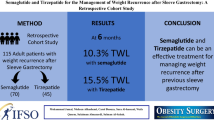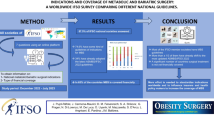Abstract
Background
This study investigated the role of proximal small intestinal bypass (PSIB) and distal small intestinal bypass (DSIB) as well as their long-term effects on weight loss and glucose metabolism in high-sugar and high-fat diet-induced obese rats.
Methods
Sprague-Dawley rats were divided into four groups: PSIB, bypassing 60% of the proximal small intestine length; DSIB, bypassing 60% of the distal small intestine length; sham-operated (Sham) animals; and control animals. All rats were fed a high-sugar and high-fat diet after surgery. The primary outcome measures were body weight, food intake, fasting blood glucose (FBG) levels, oral glucose tolerance test (OGTT), and the insulin tolerance test (ITT).
Results
Global body weight (BW) and food intake in the PSIB and DSIB groups were lower than those in the Sham group at postoperative week 2. BW and food intake in the PSIB group were lower than those in the DSIB group at postoperative week 24. The PSIB and DSIB groups exhibited improvement in glucose tolerance at postoperative weeks 4, 8, and 24. The PSIB and DSIB groups exhibited improvement in FBG at postoperative week 24, and only the DSIB group exhibited improvement in insulin sensitivity.
Conclusions
This study provides experimental evidence that PSIB surgery induced a better and more persistent weight loss effect than DSIB surgery and that the two types of intestinal bypass surgeries yielded equivalent and stable long-term improvement in glucose tolerance in an obese rat model.





Similar content being viewed by others
References
Lutrzykowski M. Vertical gastric resection (sleeve gastrectomy) in a morbidly obese patient with past jejunoileal bypass. Obes Surg. 2007;17(3):423–5.
Santoro S, Milleo FQ, Malzoni CE, et al. Enterohormonal changes after digestive adaptation: five-year results of a surgical proposal to treat obesity and associated diseases. Obes Surg. 2008;18(1):17–26.
Melissas J, ErenTaskin H, Peirasmakis D, et al. A Simple food-diverting operation for Type 2 diabetes treatment. Preliminary results in humans with BMI 28–32 kg/m2. Obes Surg. 2016.
Melissas J, Peppe A, Askoxilakis J, et al. Sleeve gastrectomy plus side-to-side jejunoileal anastomosis for the treatment of morbid obesity and metabolic diseases: a promising operation. Obes Surg. 2012;22(7):1104–9.
Alamo M, Sepúlveda M, Gellona J, et al. Sleeve gastrectomy with jejunal bypass for the treatment of type 2 diabetes mellitus in patients with body mass index <35 kg/m2. A cohort study. Obes Surg. 2012;22(7):1097–103.
Sobrino Crespo C, Perianes Cachero A, Puebla Jimenez L, et al. Peptides and food intake. Front Endocrinol (Lausanne). 2014;5:58.
Yousif MH, Makki B, El-Hashim AZ, et al. Chronic treatment with Ang-(1-7) reverses abnormal reactivity in the corpus cavernosum and normalizes diabetes-induced changes in the protein levels of ACE, ACE2, ROCK1, ROCK2 and omega-hydroxylase in a rat model of type 1 diabetes. J Diabetes Res. 2014;2014:142–54.
Kopsombut G, Shoulson R, Milone L, et al. Partial small bowel resection with sleeve gastrectomy increases adiponectin levels and improves glucose homeostasis in obese rodents with type 2 diabetes. World J Surg. 2012;36(6):1432–8.
Wang Y, Ying L, Chen YY, et al. Reprint of "induction of heme oxygenase-1 ameliorates vascular dysfunction in streptozotocin-induced type 2 diabetic rats". Vasc Pharmacol. 2014;62(3):123–31.
Duan J, Yuan L, Zhou J. Side-to-side jejunoileal anastomosis plus proximal loop ligation: a novel intestinal bypass model for diabetic rats. Obes Surg. 2014;24(1):141–2.
Caruana JA, Monte SV, Jacobs DM, et al. Distal small bowel bypass for weight regain after gastric bypass: safety and efficacy threshold occurs at <70% bypass. Surg Obes Relat Dis. 2015;11(6):1248–55.
Melissas J, Peirasmakis D, Lamprou V, et al. Is a simple food-diverting operation the solution for type 2 diabetes treatment? Experimental study in a non-obese rat model. Obes Surg. 2016;26(5):1010–5.
Patriti A, Facchiano E, Donini A. Effect of duodenal-jejunal exclusion in a non-obese animal model of type 2 diabetes: a new perspective for an old disease. Ann Surg. 2004;240(2):388–9.
Liu S, Zhang G, Wang L, et al. The entire small intestine mediates the changes in glucose homeostasis after intestinal surgery in Goto-Kakizaki rats. Ann Surg. 2012;256(6):1049–58.
Duan J, Zhou J, Ren F, et al. Mid to distal small bowel resection with the preservation of the terminal ileum improves glucose homeostasis in diabetic rats by activating the hindgut-dependent mechanism. J Gastrointest Surg. 2014;18(6):1186–93.
Pournaras DJ, Glicksman C, Vincent RP, et al. The role of bile after roux-en-Y gastric bypass in promoting weight loss and improving glycaemic control. Endocrinology. 2012;153(8):3613–9.
De Silva A, Bloom SR. Gut hormones and appetite control: a focus on PYY and GLP-1 as therapeutic targets in obesity. Gut and liver. 2012 Jan;6(1):10–20.
Kelley DE, Wing R, Buonocore C, et al. Relative effects of calorie restriction and weight loss in noninsulin-dependent diabetes mellitus. J Clin Endocrinol Metab. 1993;77(5):1287–93.
Lingvay I, Guth E, Islam A, et al. Rapid improvement in diabetes after gastric bypass surgery: is it the diet or surgery? Diabetes Care. 2013;36(9):2741–7.
Buchwald H, Estok R, Fahrbach K, et al. Weight and type 2 diabetes after bariatric surgery: systematic review and meta-analysis. Am J Med. 2009;122(3):248–56. e5
Rubino F, Forgione A, Cummings DE, et al. The mechanism of diabetes control after gastrointestinal bypass surgery reveals a role of the proximal small intestine in the pathophysiology of type 2 diabetes. Ann Surg. 2006;244(5):741–9.
Zhu J, Gupta R, Safwa M. The mechanism of metabolic surgery: gastric center hypothesis. Obes Surg. 2016;26(7):1639–41.
Oh TJ, Ahn CH, Cho YM. Contribution of the distal small intestine to metabolic improvement after bariatric/metabolic surgery: lessons from ileal transposition surgery. Journal of diabetes investigation. 2016;7(Suppl 1):94–101.
Mingrone G, Cummings DE. Changes of insulin sensitivity and secretion after bariatric/metabolic surgery. Surg Obes Relat Dis. 2016;12(6):1199–205.
Seeley RJ, Chambers AP, Sandoval DA. The role of gut adaptation in the potent effects of multiple bariatric surgeries on obesity and diabetes. Cell Metab. 2015;21(3):369–78.
Laferrere B, Reilly D, Arias S, et al. Differential metabolic impact of gastric bypass surgery versus dietary intervention in obese diabetic subjects despite identical weight loss. Sci Transl Med. 2011;3(80):80re2.
Cho YM. A gut feeling to cure diabetes: potential mechanisms of diabetes remission after bariatric surgery. Diabetes Metab J. 2014;38(6):406–15.
Chambers AP, Jessen L, Ryan KK, et al. Weight-independent changes in blood glucose homeostasis after gastric bypass or vertical sleeve gastrectomy in rats. Gastroenterology. 2011;141(3):950–8.
Kohli R, Bradley D, Setchell KD, et al. Weight loss induced by roux-en-Y gastric bypass but not laparoscopic adjustable gastric banding increases circulating bile acids. J Clin Endocrinol Metab. 2013;98(4):E708–E12.
Duan J, Tan C, Xu H, et al. Side-to-side jejunoileal bypass induces better glucose-lowering effect than end-to-side jejunoileal bypass on Nonobese diabetic rats. Obes Surg. 2015;25(8):1458–67.
Fiorucci S, Mencarelli A, Palladino G, et al. Bile-acid-activated receptors: targeting TGR5 and farnesoid-X-receptor in lipid and glucose disorders. Trends Pharmacol Sci. 2009;30(11):570–80.
Dirksen C, Jorgensen NB, Bojsen-Moller KN, et al. Mechanisms of improved glycaemic control after roux-en-Y gastric bypass. Diabetologia. 2012;55(7):1890–901.
Salinari S, le Roux CW, Bertuzzi A, et al. Duodenal-jejunal bypass and jejunectomy improve insulin sensitivity in Goto-Kakizaki diabetic rats without changes in incretins or insulin secretion. Diabetes. 2014;63(3):1069–78.
Mingrone G, Panunzi S, De Gaetano A, et al. Bariatric-metabolic surgery versus conventional medical treatment in obese patients with type 2 diabetes: 5 year follow-up of an open-label, single-Centre, randomised controlled trial. Lancet. 2015;386(9997):964–73.
Appleton GV, Bristol JB, Williamson RC. Proximal enterectomy provides a stronger systemic stimulus to intestinal adaptation than distal enterectomy. Gut. 1987;28(Suppl):165–8.
Carreras O, Delgado MJ, Murillo ML. D-Galactose absorption for the whole intestinal surface after different types of resection and bypass. Scand J Gastroenterol. 1989;24(3):304–8.
Author information
Authors and Affiliations
Corresponding author
Ethics declarations
Conflict of Interest
All of the authors declare no conflicts of interest.
Source of Funding
This work was supported by the National Natural Science Foundation of China (no.81500652), the Natural Science Foundation of Jiangxi Province (no.20161BAB215247), the Foundation of Education Department of Jiangxi Province (no. GJJ150133), and the Foundation of Health and Family Planning Commission of Jiangxi Province (no. 20171072, no.20171091).
Rights and permissions
About this article
Cite this article
Cao, J., Ren, Q., Tan, C. et al. Small Intestinal Bypass Induces a Persistent Weight-Loss Effect and Improves Glucose Tolerance in Obese Rats. OBES SURG 27, 1859–1866 (2017). https://doi.org/10.1007/s11695-017-2571-3
Published:
Issue Date:
DOI: https://doi.org/10.1007/s11695-017-2571-3




